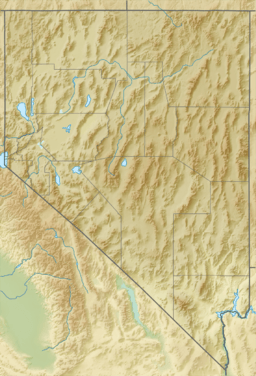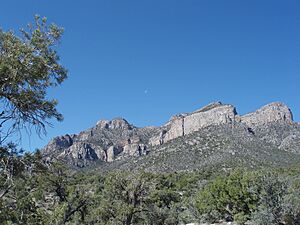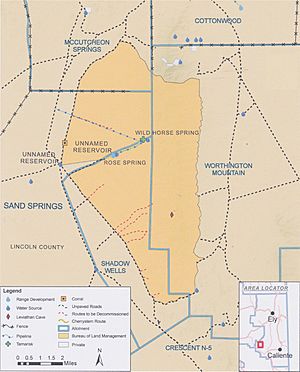Worthington Mountains facts for kids
Quick facts for kids Worthington Mountains |
|
|---|---|
| Highest point | |
| Peak | Worthington Peak |
| Elevation | 2,738 m (8,983 ft) |
| Dimensions | |
| Length | 12 mi (19 km) N-S |
| Width | 2.8 mi (4.5 km) E-W |
| Area | 25 sq mi (65 km2) |
| Geography | |
| Country | United States |
| State | Nevada |
| District | Lincoln County |
| Range coordinates | 37°53′6″N 115°36′23″W / 37.88500°N 115.60639°W |
| Topo map | USGS Worthington Peak |
The Worthington Mountains are a small mountain range in Nevada, about 12 miles (19 km) long. They stretch from north to south in Lincoln County. Valleys surround the mountains: Sand Spring Valley is to the west, and Garden Valley is to the east. Other mountain ranges are nearby, like the Quinn Canyon Range and the Golden Gate Range.
This range has two main peaks. Worthington Peak is near the north end and is about 8,983 feet (2,738 meters) high. Meeker Peak is closer to the south end and is about 8,766 feet (2,672 meters) tall. The flat areas around the mountains are much lower, from 4,900 to 5,900 feet (1,494 to 1,798 meters). There isn't much surface water or many natural springs in the mountains.
The Worthington Mountains are part of the Basin and Range National Monument. This special area was created in 2015 by President Barack Obama to protect its unique nature.
Rocks and Mining History
The Freiberg mining district is on the northeast side of the Worthington Mountains. People have been mining here for a long time. The rocks in this area are mostly limestone and dolomite. These rocks formed a very long time ago, during the Ordovician period.
Miners started looking for gold and silver in the old Freiberg mine in 1865. Later, from 1919 to 1948, the New Freiberg mine was active. Workers used both underground tunnels and open pits to find silver, lead, zinc, and copper.
In the southern part of the range, you can find rocks from the Upper Devonian period. These rocks show signs of the Alamo Impact. This was a huge event caused by a space rock hitting Earth. The main impact area is about 12 miles (19 km) south of the Worthington Mountains.
Plants and Animals
The lower parts of the Worthington Mountains are covered in sagebrush and other small shrubs. As you go higher up, you'll find forests of different trees. These include singleleaf pinyon pine and Utah Juniper. Even higher up, you can see bristlecone pine trees, which are known for living a very long time. In a couple of small spots, you might also find ponderosa pine trees.
Many large animals live in these mountains. You might spot mule deer and pronghorn. There are also desert bighorn sheep, which are wild sheep that live in the desert. Predators like bobcats and mountain lions also make their home here.
Worthington Mountains Wilderness Area
The Worthington Mountains Wilderness Area was created by the U.S. Congress in 2004. It covers most of the Worthington Mountains, about 30,664 acres (124 sq km). This wilderness area includes the wide, flat areas on the western side of the mountains. Worthington Peak is right on the northern edge of this wilderness. The very northern tip of the range, where the old mining area is, is not part of the wilderness. The wilderness area ranges in height from 4,900 feet (1,494 meters) to 8,968 feet (2,733 meters).
The Bureau of Land Management, which manages this land, says that the Worthington Wilderness is very special. They describe it as having "stark beauty, chaotic topography, and remoteness." This means it has rough, beautiful landscapes, with sharp peaks, narrow canyons, and steep slopes leading down to the desert floor.
One of the most interesting places in the wilderness is Leviathan Cave. It's located northeast of Meeker Peak. Getting to the cave is a bit difficult. You have to hike a challenging trail that climbs the east side of the mountains for more than two miles. The cave entrance is at about 7,800 feet (2,377 meters) high. To get inside, you need ropes to go down a 30-foot (9-meter) drop. Inside, the cave has cool rock formations like stalactites and stalagmites. It's about 350 yards (320 meters) long. Not many people visit the cave, only about 40 per year between 2000 and 2010.




